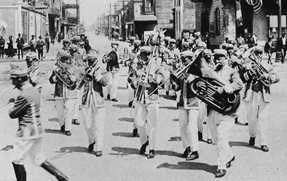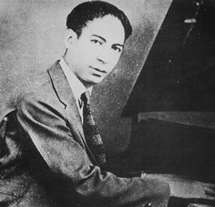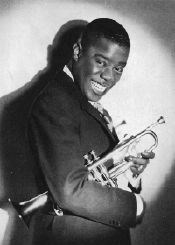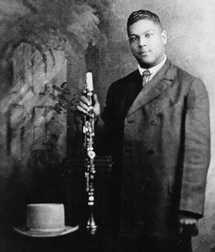Jazz Origins in New Orleans - New Orleans Jazz National Historical Park (U.S. National Park Service) (original) (raw)

Early New Orleans Brass Band
Photo Hogan Jazz Archives
Researchers and historians are still learning about jazz history; there are many and various opinions about what is important in the history of jazz. What follows is an overview of jazz history that provides a foundation for this study.
The Origins of Jazz - Pre 1895
A review of New Orleans' unique history and culture, with its distinctive character rooted in the colonial period, is helpful in understanding the complex circumstances that led to the development of New Orleans jazz. The city was founded in 1718 as part of the French Louisiana colony. The Louisiana territories were ceded to Spain in 1763 but were returned to France in 1803. France almost immediately sold the colony to the United States in the Louisiana Purchase.
New Orleans differed greatly from the rest of the young United States in its Old World cultural relationships. The Creole culture was Catholic and French-speaking rather than Protestant and English-speaking. A more liberal outlook on life prevailed, with an appreciation of good food, wine, music, and dancing. Festivals were frequent, and Governor William Claiborne, the first American-appointed governor of the territory of Louisiana, reportedly commented that New Orleanians were ungovernable because of their preoccupation with dancing.
The colony's culture was enriched not only from Europe but from Africa as well. As early as 1721 enslaved West Africans totaled 30% of the population of New Orleans, and by the end of the 1700s people of varied African descent, both free and slave, made up more than half the city's population. Many arrived via the Caribbean and brought with them West Indian cultural traditions.
After the Louisiana Purchase, English-speaking Anglo- and African-Americans flooded into New Orleans. Partially because of the cultural friction, these newcomers began settling upriver from Canal Street and from the already full French Quarter (Vieux Carre). These settlements extended the city boundaries and created the "uptown" American sector as a district apart from the older Creole "downtown." The influx of black Americans, first as slaves and later as free people, into uptown neighborhoods brought the elements of the blues, spirituals, and rural dances to New Orleans' music.
Ethnic diversity increased further during the 19th century. Many German and Irish immigrants came before the Civil War, and the number of Italian immigrants increased afterward. The concentration of new European immigrants in New Orleans was unique in the South.
This rich mix of cultures in New Orleans resulted in considerable cultural exchange. An early example was the city's relatively large and free "Creole of color" community. Creoles of color were people of mixed African and European blood and were often well educated craft and trades people. Creole of color musicians were particularly known for their skill and discipline. Many were educated in France and played in the best orchestras in the city.
In the city, people of different cultures and races often lived close together (in spite of conventional prejudices), which facilitated cultural interaction. For instance, wealthier families occupied the new spacious avenues and boulevards uptown, such as St. Charles and Napoleon avenues, while poorer families of all races who served those who were better off often lived on the smaller streets in the centers of the larger blocks. New Orleans did not have mono cultural ghettos like many other cities.
New Orleans' unusual history, its unique outlook on life, its rich ethnic and cultural makeup, and the resulting cultural interaction set the stage for development and evolution of many distinctive traditions. The city is famous for its festivals, foods, and, especially, its music. Each ethnic group in New Orleans contributed to the very active musical environment in the city, and in this way to the development of early jazz.
A well-known example of early ethnic influences significant to the origins of jazz is the African dance and drumming tradition, which was documented in New Orleans. By the mid-18th century, slaves gathered socially on Sundays at a special market outside the city's rampart. Later, the area became known as Congo Square, famous for its African dances and the preservation of African musical and cultural elements.
Although dance in Congo Square ended before the Civil War, a related musical tradition surfaced in the African-American neighborhoods at least by the 1880s. The Mardi Gras Indians were black "gangs" whose members "masked" as American Indians on Mardi Gras day to honor them. Black Mardi Gras Indians felt a spiritual affinity with Native American Indians. On Mardi Gras day gang members roamed their neighborhoods looking to confront other gangs in a show of strength that sometimes turned violent. The demonstration included drumming and call-and-response chanting that was strongly reminiscent of West African and Caribbean music. Mardi Gras Indian music was part of the environment of early jazz. Several early jazz figures such as Louis Armstrong and Lee Collins described being affected by Mardi Gras Indian processions as youngsters, and Jelly Roll Morton claimed to have been a "spyboy," or scout, for an Indian gang as a teenager.
New Orleans music was also impacted by the popular musical forms that proliferated throughout the United States following the Civil War. Brass marching bands were the rage in the late 1880s, and brass bands cropped up across America. There was also a growing national interest in syncopated musical styles influenced by African-American traditions, such as cakewalks and minstrel tunes. By the 1890s syncopated piano compositions called ragtime created a popular music sensation, and brass bands began supplementing the standard march repertoire with ragtime pieces.

Jazz Pianist Jelly Roll Morton
Photo Hogan Jazz Archives
Early Development of Jazz - 1890 to 1917
Brass bands had become enormously popular in New Orleans as well as the rest of the country. In the 1880s New Orleans brass bands, such as the Excelsior and Onward, typically consisted of formally trained musicians reading complex scores for concerts, parades, and dances.
The roots of jazz were largely nourished in the African-American community but became a broader phenomenon that drew from many communities and ethnic groups in New Orleans. "Papa" Jack Laine's Reliance Brass Bands, for instance, were integrated before segregation pressures increased. Laine's bands, which were active around 1890 to 1913, became the most well known of the white ragtime bands. Laine was a promoter of the first generation of white jazzmen.
A special collaborative relationship developed between brass bands in New Orleans and mutual aid and benevolent societies. Mutual aid and benevolent societies were common among many ethnic groups in urban areas in the 19th century. After the Civil War such organizations took on special meaning for emancipated African-Americans who had limited economic resources. The purposes of such societies were to "help the sick and bury the dead" - important functions because blacks were generally prohibited from getting commercial health and life insurance and other services.
While many organizations in New Orleans used brass bands in parades, concerts, political rallies, and funerals, African-American mutual aid and benevolent societies had their own expressive approach to funeral processions and parades, which continues to the present. At their events, community celebrants would join in the exuberant dancing procession. The phenomena of community participation in parades became known as "the second line," second, that is, to the official society members and their contracted band.
Other community organizations also used New Orleans-style "ragtime" brass bands. Mardi Gras walking clubs, notably the Jefferson City Buzzards and the Cornet Carnival Club (still in existence), were employers of the music.
By the turn of the century New Orleans was thriving not only as a major sea and river port but also as a major entertainment center. Legitimate theater, vaudeville, and music publishing houses and instrument stores employed musicians in the central business district. Less legitimate entertainment establishments flourished in and around the officially sanctioned red-light district near Canal and Rampart streets. Out on the shores of Lake Ponchartrain bands competed for audiences at amusement parks and resorts. Street parades were common in the neighborhood, and community social halls and corner saloons held dances almost nightly.
New Orleanians never lost their penchant for dancing, and most of the city's brass band members doubled as dance band players. The Superior Brass Band, for instance, had overlapping personnel with its sister group, The Superior Orchestra. Dance bands and orchestras softened the brass sound with stringed instruments, including violin, guitar, and string bass. At the turn of the century string dance bands were popular in more polite settings, and "dirty" music, as the more genteel dances were known, was the staple of many downtown Creole of color bands such as John Robichaux's Orchestra.
But earthier vernacular dance styles were also increasing in popularity in New Orleans. Over the last decade of the 19th century, non reading musicians playing more improvised music drew larger audiences for dances and parades. For example, between 1895 and 1900 uptown cornet player Charles "Buddy" Bolden began incorporating improvised blues and increasing the tempo of familiar dance tunes. Bolden was credited by many early jazzmen as the first musician to have a distinctive new style. The increasing popularity of this more "ratty" music brought many trained and untrained musicians into the improvising bands. Also, repressive segregation laws passed in the 1890s (as a backlash to Reconstruction) increased discrimination toward anyone with African blood and eliminated the special status previously afforded Creoles of color. These changes ultimately united black and Creole of color musicians, thus strengthening early jazz by combing the uptown improvisational style with the more disciplined Creole approach.
The instrumentation and section playing of the brass bands increasingly influenced the dance bands, which changed in orientation from string to brass instruments. What ultimately became the standard front line of a New Orleans jazz band was cornet, clarinet, and trombone. These horns collectively improvising or "faking" ragtime yielded the characteristic polyphonic sound of New Orleans jazz.
Most New Orleans events were accompanied by music, and there were many opportunities for musicians to work. In addition to parades and dances, bands played at picnics, fish fries, political rallies, store openings, lawn parties, athletic events, church festivals, weddings, and funerals. Neighborhood social halls, some operated by mutual aid and benevolent societies or other civic organizations, were frequently the sites of banquets and dances. Early jazz was found in neighborhoods all over and around New Orleans - it was a normal part of community life.
Sometime before 1900, African-American neighborhood organizations known as social aid and pleasure clubs also began to spring up in the city. Similar in their neighborhood orientation to the mutual aid and benevolent societies, the purposes of social and pleasure clubs were to provide a social outlet for its members, provide community service, and parade as an expression of community pride. This parading provided dependable work for musicians and became an important training ground for young musical talent.
New Orleans jazz began to spread to other cities as the city's musicians joined riverboat bands and vaudeville, minstrel, and other show tours. Jelly Roll Morton, an innovative piano stylist and composer, began his odyssey outside of New Orleans as early as 1907. The Original Creole Orchestra, featuring Freddie Keppard, was an important early group that left New Orleans, moving to Los Angeles in 1912 and then touring the Orpheum Theater circuit, with gigs in Chicago and New York. In fact, Chicago and New York became the main markets for New Orleans jazz. Tom Brown's Band from Dixieland left New Orleans for Chicago in 1915, and Nick LaRocca and other members of the Original Dixieland Jazz Band headed there in 1916.

Jazz Trumpeter Louis Armstrong
Photo Hogan Jazz Archives
Maturation of Jazz - 1917 to the Early 1930s
In 1917 the Original Dixieland Jazz Band cut the first commercial jazz recording while playing in New York City, where they were enthusiastically received. The Victor release was an unexpected hit. Suddenly, jazz New Orleans style was a national craze.
With the new demand for jazz, employment opportunities in the north coaxed more musicians to leave New Orleans. For example, clarinetist Sidney Bechet left for Chicago in 1917, and cornetist Joe "King" Oliver followed two years later. The appeal of the New Orleans sound knew no boundaries. By 1919 the Original Dixieland Jazz Band was performing in England and Bechet was in France; their music was wholeheartedly welcomed.
King Oliver, who had led popular bands in New Orleans along with trombonist Edward "Kid" Ory, established the trend-setting Creole Jazz Band in Chicago in 1922. Also in Chicago, the New Orleans Rhythm Kings blended the Oliver and Original Dixieland Jazz Band sounds and collaborated with Jelly Roll Morton in 1923.
Perhaps the most significant departure from New Orleans was in 1922 when Louis Armstrong was summoned to Chicago by King Oliver, his mentor. Louis Armstrong swung with a great New Orleans feeling, but unlike any of his predecessors, his brilliant playing led a revolution in jazz that replaced the polyphonic ensemble style of New Orleans with development of the soloist's art. The technical improvement and popularity of phonograph records spread Armstrong's instrumental and vocal innovations and make him internationally famous. His Hot Five and Hot Seven recordings (1925-28), including his celebrated work with Earl Hines, were quite popular and are milestones in the progression of the music.
Jelly Roll Morton, another New Orleans giant, also made a series of influential recordings while based in Chicago in the 1920s. Morton's compositions added sophistication and a structure for soloists to explore, and his work set the stage for the Swing era.
New Orleans musicians and musical styles continued to influence jazz nationally as the music went through a rapid series of stylistic changes. Jazz became the unchallenged popular music of America during the Swing era of the 1930s and 1940s. Later innovations, such as bebop in the 1940s and avant-garde in the 1960s, departed further from the New Orleans tradition.
Once the small-band New Orleans style fell out of fashion, attempts were made to revive the music. In the late 1930s, recognizing that early jazz had been neglected and deserved serious study, jazz enthusiasts turned back to New Orleans. Many New Orleans musicians and others were still actively playing traditional jazz. Recordings and performances by Bunk Johnson and George Lewis stimulated a national jazz revival movement, providing opportunities for traditional jazz players that persist today.

Jazz Clarinetist/Saxophonist Sidney Bechet
Photo Hogan Jazz Archives
Quotations from Jazz Pioneers on the Early History of Jazz
Sidney Bechet, "Treat It Gentle"
There was this club, too, that we played at, the Twenty-Five Club. That was about 1912, 1913; and all the time we played there, people were talking about Freddie Keppard. Freddie, he had left New Orleans with his band and he was traveling all over the country playing towns on the Orpheum Circuit. At the time, you know, that was something new and Freddie kept sending back all these clippings from what all the newspapermen and the critics and all was writing up about him, about his music, about his band. And all these clippings were asking the same thing: where did it come from? It seems like everyone along the circuit was coming up to Freddie to ask about this ragtime. Especially when his show, the Original Creole Band, got to the Winter Gardens in New York...that was the time they was asking about it the most. Where did it come from? And back at the Twenty-Five these friends of Freddie's kept coming around and showing these clippings, wanting to know what it was all about. It was a new thing then.
Baby Dodds, "The Baby Dodds Story"
[Big Eye Louis Nelson] lived downtown, and I lived uptown. He was on the north side of town, and I was living on the south side. In other words, he was a Creole and lived in the French part of town. Canal Street was the dividing line and the people from the different sections didn't mix. The musicians mixed only if you were good enough. But at one time the Creole fellows thought uptown musicians weren't good enough to play with them, because most of the uptown musicians didn't read music. Everybody in the French part of town read music.
Louis Armstrong, "Satchmo: My Life in New Orleans"
The funerals in New Orleans are sad until the body is finally lowered into the grave and the reverend says, "ashes to ashes and dust to dust." After the brother was six feet under the ground the band would strike up one of those good old tunes like "Didn't He Ramble", and all the people would leave their worries behind. Particularly when King Oliver blew that last chorus in high register.
Once the band starts, everybody starts swaying from one side of the street to the other, especially those who drop in and follow the ones who have been to the funeral. These people are known as 'the second line', and the may be anyone passing along the street who wants to hear the music. The spirit hits them and they follow along to see what's happening.
Pops Foster, "Pops Foster: The Autobiography of a New Orleans Jazzman"
From about 1900 on, there were three types of bands playing in New Orleans. You had bands that played ragtime, ones that played sweet music, and the ones that played nothin' but blues. A band like John Robichaux's played nothin' but sweet music and played the dirty affairs. On a Saturday night Frankie Duson's Eagle Band would play the Masonic Hall because he played a whole lot of blues. A band like the Magnolia Band would play ragtime and work the District...All the bands around New Orleans would play quadrilles starting about midnight. When you did that nice people would know it was time to go home because things got rough after that.
Jelly Roll Morton, "Mr. Jelly Roll" (Alan Lomax)
You see, New Orleans was very organization-minded. I have never seen such beautiful clubs as they had there...the Broadway Swells, the High Arts, the Orleans Aides, the Bulls and Bears, the Tramps, the Iroquois, the Allegroes...that was just a few of them, and those clubs would parade at least once a week. They'd have a great big band. The grand marshal would ride in front with his aides behind him, all with expensive sashes and streamers.
Nick LaRocca (interviewed by Richard Allen, May 26, 1958)
"[T]he Livery Stable Blues" became a national hit. It was all over the world, even down in Honolulu and all where American forces went...we entertained over a million men... I played on the bill with Caruso. I played on the bills with Jolson. I played on the bills with Eddie Cantor.
This history was prepared by a National Park Service study team to be included in the Special Resource Study and Environmental Assessment of Suitable/Feasible Alternatives for the New Orleans Jazz National Historical Park in 1993.
Sources of Contribution: Subcommittee Participants
Jack Stewart, PhD Michael White, PhD John Hasse Bruce Raeburn, PhD Ellis Marsalis Joan Brown
Sources of Contribution: Bibliography